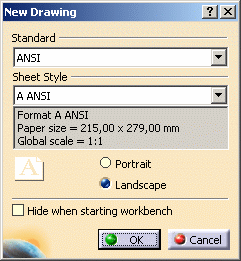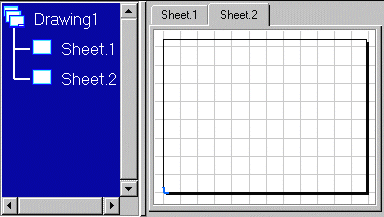For more information about accessing the Interactive Drafting workbench, see Entering the Interactive Drafting Workbench.
-
Click the New icon
 or select File > New. The New dialog
box is displayed.
or select File > New. The New dialog
box is displayed. -
Select Drawing from the List of Types field, and click OK.
-
From the New Drawing dialog box, select the ANSI standard. Among other things, the sheet style defines the sheet format, size, scale and default orientation.
-
Select the A ANSI sheet style.
-
Optionally change the default orientation.
-
Optionally select the Hide when starting workbench option, if you do not want the New Drawing dialog box to appear the next time you enter the Interactive Drafting workbench via the Start menu.

In this case, the last selected standard, sheet style and orientation will be used by default when creating a drawing. You will always be able to reactivate this dialog box by unselecting the Hide when starting workbench option available via Tools > Options > Mechanical Design > Drafting > General tab. -
Click OK.

What you need to know when defining a sheet
- Standards and sheet styles are defined by the administrator in the Standards Editor, who can add an unlimited number of them. Care that any customized standard is based on one of the four international standards (ANSI, ISO,ASME or JIS) as far as basic parameters are concerned. For more details, see Sheet Format Definition and Sheet styles in the Administration Tasks chapter.
- You can create your own user-defined sheet formats, defined locally for a given drawing, via the sheet properties. Refer to Editing Sheet Properties > Format properties for more information.
- Note that sheet styles are listed in alphabetical order in the New Drawing dialog box, which is not the case in the Standards Editor.
- The global scale is a scaling factor which applies to all
views in a given sheet. It does not determine the position of the views
(or any other object) contained in the sheet.
When the grid is displayed, the position of the view in the sheet is not determined by the grid, which only deals with what is drawn directly in the sheet. To see the real position of a given view in a sheet, you need to use the ruler. It is the only way to see the real coordinates in a sheet referential. - At any time after defining a sheet, you can change the standard (which you can update), sheet style or orientation. To do this, click File > Page Setup to display the Page Setup dialog box. Refer to Modifying a Sheet for more information.
- You can also change the standard and the sheet properties in the Properties dialog box. To do this, right-click the sheet, and select Properties... from the contextual menu. Refer to Editing Sheet Properties for more information.
- If you select a new standard, the value in the Apply to field becomes All sheets and the new standard is applied to all drawing sheet annotations.
- To add a new sheet, click the
New Sheet icon
 .
The new sheet automatically appears as follows:
.
The new sheet automatically appears as follows:

To activate a sheet once you have created more than one, double-click this sheet from the specification tree.